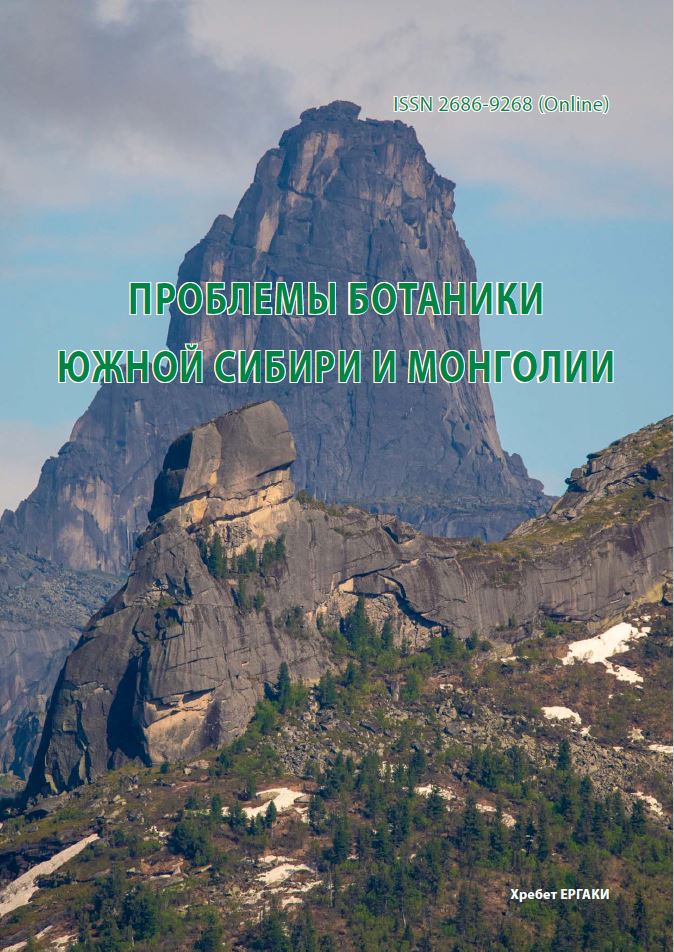Extraordinary genetic diversity in Uzbekistan wild roses (Rosa)
УДК 582.734.4+575.857(575.1)
Abstract
We have studied a population of Rosa kokanica from slopes of the Greater Chimgan Mt. in Tashkent Region of Uzbekistan. We reconstructed a statistical parsimony network of ndhC-trnV chloroplast intergenic spacer for 34 samples from three subpopulations found in valleys of the northern, southern and south-western macro slopes of the mountain. The study revealed 19 haplotypes, one of which, the basal internal haplotype 1, was shared between the northern and southern subpopulations, while 13 unique haplotypes were found in the south-western subpopulation. We suppose that such a kind of genetic structure could arise during long lasting isolation of the subpopulations in glacial times.
Downloads
Metrics
References
Введенский А. И., Пазий В. К. Rosa L. - Шиповник // Флора Узбекистана. - Ташкент: Изд-во АН Узб. ССР, 1955. - Т. 3. - С. 343-355.
Фисюн В. В. Шиповник, Роза - Rosa L. // Флора Казахстана. - Алма-Ата: Изд-во АН Каз. ССР, 1961. - Т. 4. -С. 485-502.
Borchsenius F. FastGap 1.2. Department of Biosciences. - Denmark: Aarhus University, 2009. URL: http://www.aubot. dk/FastGap_home.htm
ClementM., Posada D., Crandall K. A. TCS: a computer program to estimate gene genealogies // Molec. Ecol., 2000. -Vol. 9. - P. 1657-1659. DOI: 10.1046/j.1365-294x.2000.01020.x
Criscuolo A., Gribaldo S. BMGE (block mapping and gathering with entropy): a new software for selection of phylogenetic informative regions from multiple sequence alignments // B.M.C. Evol. Biol., 2010. - Vol. 10. - P. 210. DOI: 10.1186/1471-2148-10-210
Cui G., Robertson K. R. Rosa L. // Flora of China. - Beijing: Science Press, St. Louis: Missouri Botanical Garden Press, 2003. - Vol. 9. - P. 339-381.
Fer T., Vasak P., Vojta J., MarholdK. Out of the Alps or Carpathians? Origin of Central European populations of Rosa pendulina // Preslia, 2007. - Vol. 79. - P. 367-376.
Fougere-Danezan M., Joly S., Bruneau A., Gao X. F., Zhang L. B. Phylogeny and biogeography of wild roses with specific attention to polyploids // Ann. Bot. (Oxford), 2015. - Vol. 115. - P. 275-291. DOI: 10.1093/aob/mcu245
Gao Y.-D., Zhang Y., Gao X.-F., Zhu Z.-M. Pleistocene glaciations, demographic expansion and subsequent isolation promoted morphological heterogeneity: A phylogeographic study of the alpine Rosa sericea complex (Rosaceae) // Sci. Rep., 2015. - Vol. 5. - 11698. DOI: 10.1038/srep11698
Hall T.A. BioEdit: a user-friendly biological sequence alignment editor and analysis program for Windows 95/98/NT // Nucleic Acids Symposium Series, 1999. - Vol. 41. - P. 95-98.
Katoh K., Misawa K., Kuma K., Miyata T. MAFFT: a novel method for rapid multiple sequence alignment based on fast Fourier transform // Nucl. Acids Res., 2002. - Vol. 30. - P. 3059-3066. DOI: 10.1093/nar/gkf436
Katoh K., Standley D. M. MAFFT multiple sequence alignment software version 7: improvements in performance and usability // Molec. Biol. Evol., 2013. - Vol. 30. - P. 772-780. DOI: 10.1093/molbev/mst010
Nucleotide. Bethesda (MD): National Library of Medicine (US), National Center for Biotechnology Information. URL: https://www.ncbi.nlm.nih.gov/nuccore/ (Accessed 15.05.2023).
Shaw J., Lickey E. B., Schilling E. E., Small R. L. Comparison of whole chloroplast genome sequences to choose noncoding regions for phylogenetic studies in angiosperms: The tortoise and the hare III. // Am. J. Bot., 2007. - Vol. 94(3). - P. 275-288. DOI:10.3732/ajb.94.3.275
Simmons M. P., Ochoterena H. Gaps as characters in sequence-based phylogenetic analyses // Syst. Biol., 2000. -Vol. 49(2). - P. 369-381. DOI: 10.1093/sysbio/49.2.369
Templeton A. R., Crandall K. A., Sing C. F. A cladistic analysis of phenotypic associations with haplotypes inferred from restriction endonuclease mapping and DNA sequence data. III. Cladogram estimation // Genetics, 1992. - Vol. 132. -P. 619-633.
Zhang C., Li S.-Q., Xie H.-H., Liu J.-Q., Gao X.-F. Comparative plastid genome analyses of Rosa: Insights into the phylogeny and gene divergence // Tree Genet. Genomes, 2022. - Vol. 18. - P. 20. DOI: 10.1007/s11295-022-01549-8



